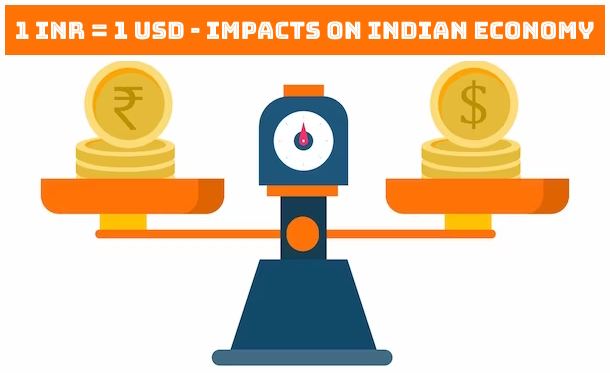Impacts of a Hypothetical Exchange Rate of 1 Rupee to 1 USD on the Indian Economy
If 1 rupee were equal to 1 USD, it would represent a significant change in the global economic landscape, and such a scenario is highly unlikely to occur. However, if we consider this hypothetical scenario, there could be several potential impacts:
Table of Contents
- 1 Potential Impacts – 1 INR = 1 USD
- 1.1 1. Trade Imbalance
- 1.2 2. Inflation
- 1.3 3. Investment and Capital Flows
- 1.4 4. Tourism
- 1.5 5. Currency Reserves
- 1.6 6. Balance of Payments
- 1.7 7. Fiscal Policy
- 1.8 8. Investment Opportunities
- 1.9 9. Competition
- 1.10 10. Standard of Living
- 1.11 11. Job Creation
- 1.12 12. Foreign Debt
- 1.13 13. Banking System
- 1.14 14. Diplomatic Relations
Potential Impacts – 1 INR = 1 USD

1. Trade Imbalance
Indian exports would become much more expensive for foreign buyers, while imports would become much cheaper for Indian consumers. This could lead to a significant trade imbalance, where Indian exports decline while imports increase.
2. Inflation
Such a dramatic shift in the exchange rate could lead to inflationary pressures in India. Imports would become significantly cheaper, leading to increased demand for imported goods, while exports would become more expensive, reducing demand for Indian goods.
3. Investment and Capital Flows
Investors may start selling their investments in India, leading to a reduction in foreign investment. Additionally, individuals and entities may look for opportunities to move capital out of India to take advantage of better returns elsewhere.
4. Tourism
If 1 rupee was equal to 1 USD, India could become a more attractive destination for tourism, as the cost of living would be lower for foreign visitors, making it more affordable to travel and stay in India.
5. Currency Reserves
The Reserve Bank of India would need to manage its foreign currency reserves differently since the value of its reserves would drop dramatically, potentially impacting its ability to manage its currency and economy.
6. Balance of Payments
A 1:1 exchange rate could lead to significant imbalances in the balance of payments as India’s export competitiveness would decline while its imports would become cheaper.
7. Fiscal Policy
The Indian government’s fiscal policy would need to be reevaluated, as a significant portion of government revenue comes from import and export taxes, which would be impacted by a 1:1 exchange rate.
8. Investment Opportunities
A 1:1 exchange rate could potentially create investment opportunities for foreign investors who could take advantage of India’s cheaper labor force and lower operating costs.
9. Competition
Indian companies could face greater competition from foreign companies since the cost of production for foreign companies would become cheaper.
10. Standard of Living
The cost of living in India would decrease for foreign visitors, while the cost of living for Indian citizens could increase if inflationary pressures emerge.
11. Job Creation
Cheaper labor costs could make India more attractive to foreign companies looking to invest, leading to job creation in the country.
12. Foreign Debt
India’s foreign debt obligations could become cheaper to pay off in a 1:1 exchange rate scenario, as India would effectively owe less in USD.
13. Banking System
Indian banks would need to manage their foreign currency holdings differently, as a significant portion of their holdings would decrease in value.
14. Diplomatic Relations
A 1:1 exchange rate could impact India’s diplomatic relations with other countries, particularly with the United States, which is India’s largest trading partner.
Overall, if 1 rupee was equal to 1 USD, it would have significant implications for the Indian economy and its relationships with other countries. However, it is important to note that such a scenario is highly unlikely to occur due to the complex nature of global economics and exchange rates.


